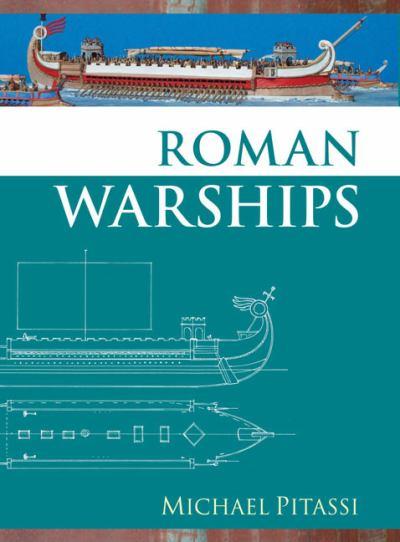
Michael Pitassi
Roman Warships
Rochester, NY: Boydell, 2011. 191 $90.00. ISBN 9781843836100.
Michael Pitassi’s Roman Warships’ aims to supply an overview of the development and evolution of the Roman warship through an interpretation of the controversial, but (limited) archaeological, iconographic, and literary evidence. It is apparent from the very beginning of the text that the quantity and quality of the data upon which the author bases his findings are problematic. For example, the technical term “ship” in the literary sources presents a challenge: “The translation or transliteration of terms relating to ancient warships is an area littered with academic argument, but one which, without the addition of ‘hard’ evidence—that is to say the real thing or more definitive discoveries, at least—remains largely speculative” (17). Even the first mention of a Roman warship in the surviving accounts only dates to 394bc, 350 years after the founding of the Rome, which further muddies the waters and set high hurdles for the goals of this text. However, the book valiantly attempts (and succeeds) to draw a picture of what the Roman warships might have been like, how they maneuvered, sailed, rowed, and changed throughout time. Pitassi delves expertly into the intricate data that he has amassed for this text—some of which, because of the technical complexity of the information, require a reader experienced in all things nautical.
It is always gratifying to read a text that is well written, unambiguous, and easy to follow, with meticulous, accurate, and up-to-date scholarship and bibliography. Pitassi has produced an admirable work on the Roman warship, about which, as the author notes, “there are, to date, no known surviving accurate, detailed drawings, diagrams, or descriptions” (4). Moreover, although remains of other Roman seafaring ships are known, “no example of what is incontestably a Roman seagoing warship has yet been found” (10). Notwithstanding the lack or scarcity of data, Pitassi does not argue ex silentio, but supplies twenty-five color plates, ninety-two figures, twenty-nine plans of images, and an abundance of literary sources that help elucidate what the ancient Roman warship might have been like. Pitassi includes among the images the celox, early imperial liburnians, triremes, figureheads, warships on coins, Greek-style pentaconters, wall painting details that include Roman ships, diagrams of Medieval and Renaissance rowing systems, terracotta models, reliefs, coins, and many other instructive and illuminating representations. This book is worth recommending just for the ample collection of the its images alone.
Pitassi materials on warships in Appian, Caesar, Dio Cassius, Herodotus, Homer, Livy, Pliny, Polybius, Procopius, Silius Italicus, Tacitus, Thucydides, Vegetius, Xenophon, and Zosimus. All of the passages from these authors are handled as best as possible—it must be kept in mind that Pitassi is working with the development of a military weapon that has a far-ranging chronology, literary support that hints but does not prove, and partial, tangible archaeological corroboration. Pitassi writes:
Commencing with the surviving ancient literature, if soon becomes obvious that there is little in the way of detailed descriptions of warships. There are only a few exceptions, and one that comes to mind is Caesar, in his Gallic Wars, describing the ships of the Celtic Venetii of Brittany but, frustratingly for us, failing to describe his own ships, presumably because the audience for whom he was writing were au fait with them. Warships are mentioned, for example, by Livy and Tacitus among others, but as part of their narrative only and are not described. Polybius, as a member of Scipio’s entourage, actually voyaged on warships during the Third Punic War (149–146 BC) and Tacitus, in the late first century ad as part of Agricola’s entourage, also saw and probably travelled on them. Both give few clues which would enable a picture of those warships to be formed. (3)
Pitassi is very methodical in his arrangement and discussion of his materials. Pitassi organizes his book as follows:
- Introduction
- PART I INTERPRETATION
- Chapter 1: Sources
- [Literature, Iconography, Archaeology]
- Chapter 2: Interpreting the Sources
- [The Literary Sources, The Iconography, The Parameters, Oar Systems, Some problems of Interpretation]
- Chapter 3: Ship Fittings
- [The Ram, Figureheads, Boarding, Towers, Artillery, Sailing and Rig, Pumps, Anchors, Hatches and Ventilation, Rudders, Deck Fittings, Awnings, Gangways, Ship’s Boats, Foredeck Structures])
- PART II THE SHIPS
- Chapter 4: The Earliest Types: Eighth to Fourth Centuries BC
- Chapter 5: Naval Ascendancy: Third and Second Centuries BC
- Chapter 6: Civil Wars and Imperial Fleets: First Centuries BC and AD
- Chapter 7: Height of Empire: Second and Third Centuries AD
- Chapter 8: The Late Empire: Fourth and Fifth Centuries AD
- Chapter 9: Terminus
- APPENDICES
- Appendix I: Service Lives of Ship Types
- Appendix II: Types of Roman Warship
- Appendix III: Gazetteer: Where to See Roman Boats and Ships
- Appendix IV: Glossary of Nautical Terms Used
- Bibliography
- Index
The book is free of typographical or factual errors, is straightforward in style, and does what it set out to do. However, as Pitassi himself notes, all of the wonderful interpretations accomplished in the book may be changed or modified at some later date: “No claim is made, nor can be made, that they are in any way definitive or the last word on the subject, which will always have to await the discovery, for each type, of an actual example of a Roman warship of sufficient completeness to settle the question once and for all” (xii). This book is recommended for the students of ancient warfare, maritime history, and Roman culture.
